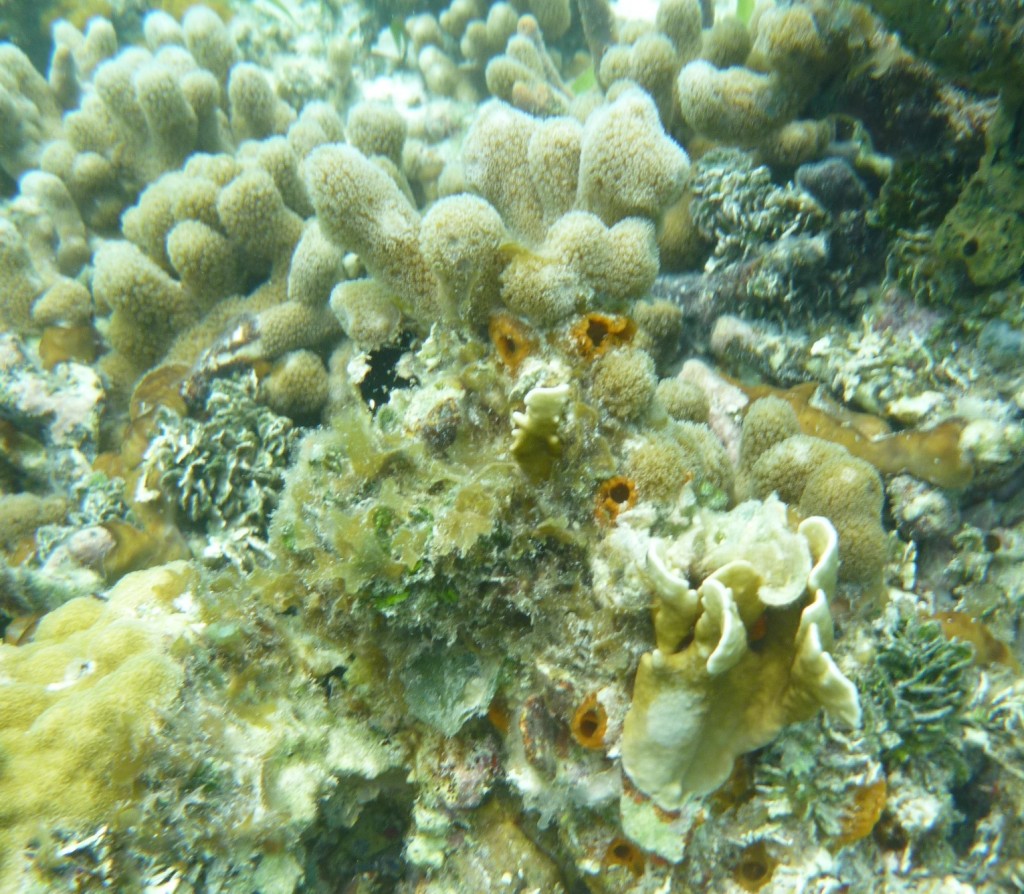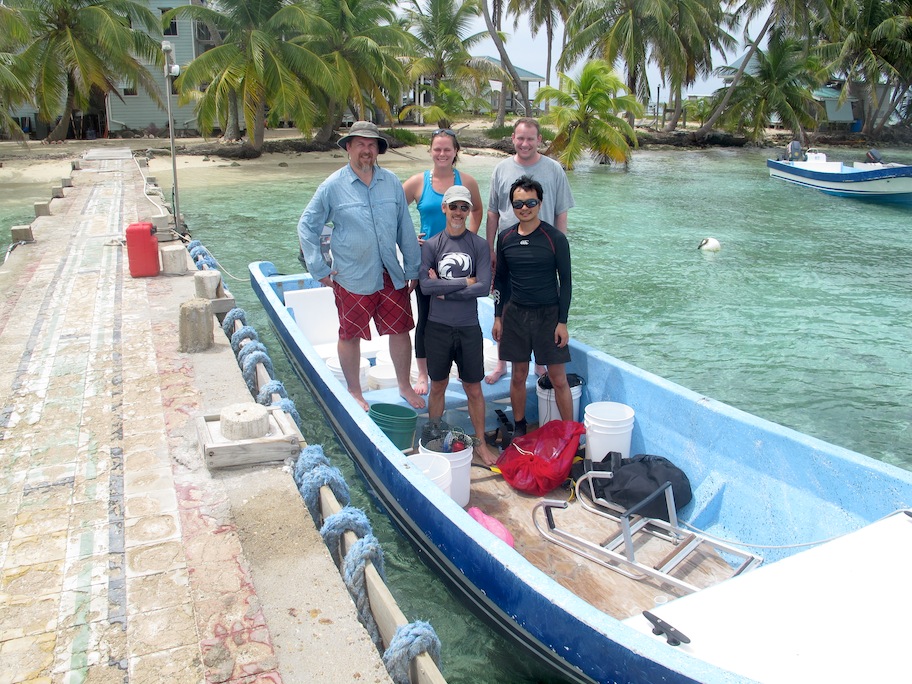
[The final post in our Belize series from the New York Times Scientist at Work blog]:
Tuesday, July 10
As the days tick away, so do our last hopes of finding social shrimp. We came to Carrie Bow to collect two types of eusocial shrimp, each living in colonies with a single queen and dozens to hundreds of nonbreeding workers. Although Emmett has collected dozens of such colonies here over the past two decades, we need new specimens for advanced genetic and reproductive studies. Now it seems we will have to scrap those plans. At this point, we can safely say that eusocial shrimp are gone from Carrie Bow. Over the past few days, we’ve sampled nearly 20 reefs, each unique and surprisingly beautiful it its own way. Some are covered by mats of corals and sea fans. Others are dotted with mounds of coral. Fish are abundant on some, but not on others. We see squids, sharks, rays, turtles and eels. We sample reefs to the east, and reefs to the west. We head far south, and stay north near the station. We try deeper ones and shallower ones. Some have more live coral, some are more degraded. Yet one thing is consistent: no eusocial shrimp.
Today we make one final attempt to sample along the outer fore reef before the bottom drops off and descends toward the continental shelf. Snorkeling down to the bottom is much harder here, not only because it’s deeper, but also because the current is stronger and the waves at the surface are bigger. Because swimming against the current is ineffective and we need to cover a large area, we pull Emmett on a tow line behind the boat as he searches for the corals that used to harbor the sponges containing eusocial shrimp. The corals we need are also all but gone, replaced by other species. The remaining rubble is old and overgrown with different sponges from the ones we need. After a few unsuccessful hours, we conclude that even out here, the shrimp are nowhere to be found.
Perhaps sensing our despair, some visitors try to cheer us up. A group of bottlenose dolphins approaches the boat. As most dolphins do, they like to play in our wake, jumping and surfing as the boat cuts through the waves. Our clapping and cheering keeps them coming back for more. But these individuals are a bit friskier than most. Not only do they demonstrate their acrobatics repeatedly, but they also wrestle for us. Quickly we realize that the wrestlers are a male and a female; the one showing off the most is much larger than the other. They aren’t playing or doing tricks for us. Twisting and turning under the bow, bumping their bellies again and again, they are trying to copulate. A second large dolphin swoops in to break it up. The three dolphins tussle for a while, rolling around one another in a ball, eventually swimming off to join the rest of the group. If that was in fact a copulation, it sure didn’t last long. We head back to shore empty-handed, clearly more frustrated than the dolphins.
The dolphins aren’t the only sea creatures in a romantic mood on this day. While dissecting some of the sponges later that evening, we put two stomatopods together into a tank to observe them. Within seconds they began to copulate. Stomatopods, or mantis shrimp, are fascinating creatures. They are not true shrimps like Synalpheus, but like snapping shrimp they live in the coral rubble. These hunters have powerful claws that they use to spear or smash prey. Much like Synalpheus’s snap, the stomatopod’s strike can be deadly to marine invertebrates or small fish — and it can injure unsuspecting marine biologists. There are more than 400 species of stomatopods in the world, and we’ve found several in the rubble over the past week. Luckily for us, none have tried to spear our fingers.
It doesn’t stop with the stomatopods. Under the outhouse dock we see more fireworks. Tiny polychaete worms are having a mating orgy. It’s a dark night and the moon is not up yet. We can’t see the animals themselves, but every few seconds one of them lights up and we soon see their release of bioluminescent sperm. They look like fireflies in the water. Floating above the sea grass in the shallows, males are hunting for females on this dark night. Between this and the lightning last week, we don’t feel so bad about missing the Fourth of July.

Our last morning is spent cleaning up. We rinse our dive gear and pack away the equipment. Our samples are all bundled up, and our export permit awaits us on the mainland. We take a final swim, a lap around the island to get some exercise and see if we can find the dolphins again. A colleague of Emmett’s who studies sponges arrives with the supply boat that has come to pick us up. We tell her our story of the past week. She is not surprised. She has been monitoring sponges here and throughout the Caribbean for the past few decades and says that sponges are declining everywhere. Disease. Changes in water temperature. Increased human and natural disturbance. There are many reasons why sponges like the ones we were searching for might be in decline. We don’t yet know the reason that some of the encrusting sponges and their snapping shrimp guests have disappeared from Carrie Bow, but we have some ideas. We’ll have a few more hours at the hotel tonight, and then at the airport tomorrow, to look back at some long-term data and discuss our next steps.
We spend our last night in Belize in the town of Dangriga. It’s a sleepy coastal town, oozing with Garifuna culture. The Garifuna are an ethnic group descended from African slaves in this part of the Caribbean. They have a distinct language, and we can’t understand a word of it. Over our final round of rum and tonic before dinner, we discuss the past two weeks. Although we didn’t get all the samples we wanted, we documented a rapid and important change in the shrimp community. As we look back at the long-term data, we uncover subtler signs of decline from the last trip, in 2009. Although we were finding eusocial shrimp then, the colonies were much smaller than they had been, and many lacked queens. We quickly realize that we may have been seeing the same thing on our last collecting trip to Jamaica, in January. We found a number of eusocial species, but they were harder to find than they had been previously, and the colonies were generally smaller and many lacked queens.
Could what happened at Carrie Bow be happening in Jamaica and elsewhere? Only time and more study will tell. Our results highlight the increasing importance of long-term collection-based studies like this in an era of accelerating global change. The specimens that Emmett and his colleagues have collected carefully for more than 20 years are but a tiny fraction of the reef’s biodiversity, yet they reveal an important picture that might be missed by more typical studies of corals or fishes. The inconspicuous shrimp offer a different and complementary window into how and potentially why the ecosystem is changing. We clearly still have much work to do to understand the evolution of social living in shrimp, but now we must also study why these social shrimp are going locally extinct throughout the Caribbean. Is there something about living in large groups that makes eusocial species more prone to extinction, or are their preferred host sponges most susceptible to change? Next week, Emmett will be synthesizing the field data, trying to solve this puzzle, while I will be back in the lab, extracting DNA and determining the genetic structure of shrimp colonies. Sadly, I won’t be working with samples from this trip, but the questions raised here will weigh on me for the weeks and months to come. As is the case in all good science, as we try to answer one question, many more arise. I’m sure we’ll be back to Carrie Bow again soon to tackle a new generation of questions.
Leave a Reply